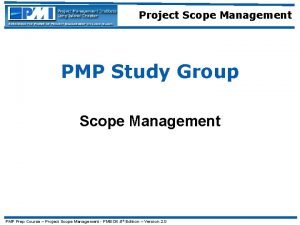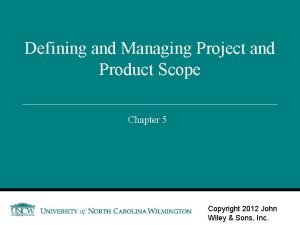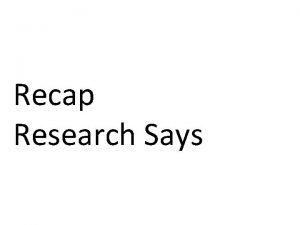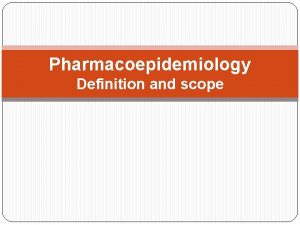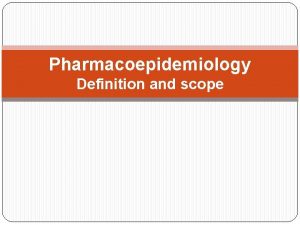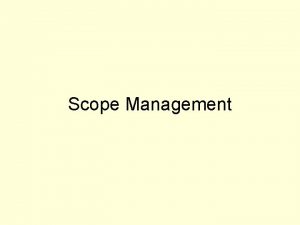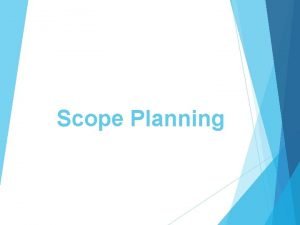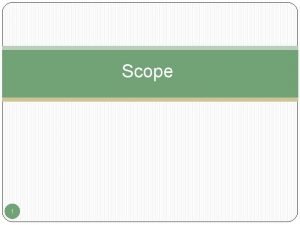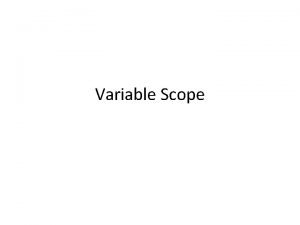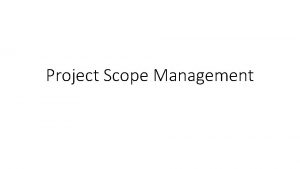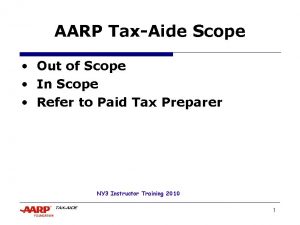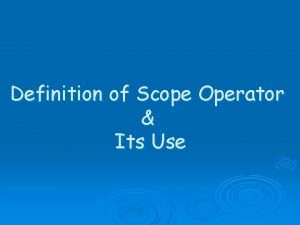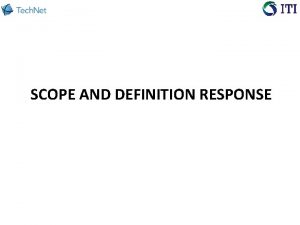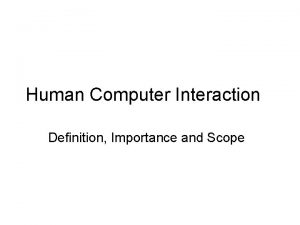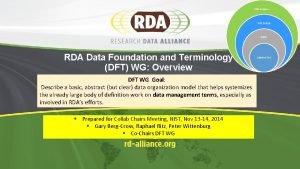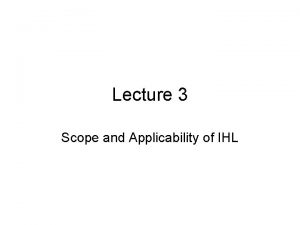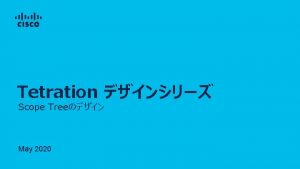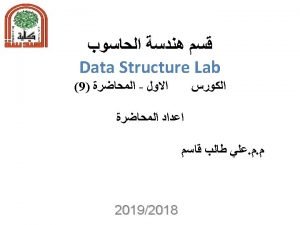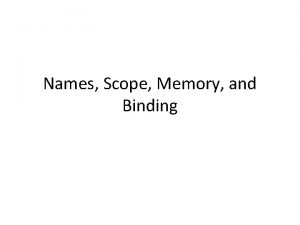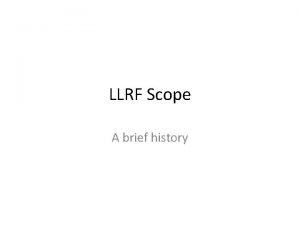Research Definition Why Research Scope of Research The



























- Slides: 27


• Research Definition • Why Research? • Scope of Research • The Differences between Project and Research • The Differences between Research and Technology • Research Category

RE + SEARCH Repeat ---- again and again To find out something Observe Person Collection of Data Phenomenon Again and again Conclusion Analysis of Data

Research is a human activity based on intellectual investigation and aimed at discovering, interpreting, and revising human knowledge on different aspects of the world. Research is the method used to accumulate scientific knowledge. Roscoe, J. T. (1975) Research is any conscious premeditated (planned/ intended/ studied) inquiry – any investigation which seeks to increase one’s knowledge of a given situation. Goldhor, H. (1972)

Planning a Research Method Collecting Data Explaining the Data Report the Findings

Systematic process of collecting and analyze data to develop a plan of action based on the facts discovered Its function is to understand the study & to communica te Research an organized study through systematic investigation of a subject To solve the problem or question by using scientific study in order to discover new facts, establish or revise a theory,

§ To add to the body of knowledge § To solve a problem § To find out what happen § To find evidence to inform practice § To develop a greater understanding of people or their world 7

§ To contribute to other people’s well-being § To contribute to personal needs § To test or disprove a theory § To come out with a better way § To understand another person’s point of view § To create more interest in the researcher 8

§ A new or improved product § A new theory § A re-interpretation of an existing theory § New or improved research tool or technique § A new or improved model or perspective § An in-depth study of a particular situation § An exploration of a topic, area or field § A critical analysis § Unanticipated outcomes 9

§ Playing with technology § Book report § Programming project § Doing what others have already done § However, each of these can be done as part of research

ü Researchers never process. move in a straight line from beginning to the end of the research ü Research always loops back and forth, moving forward a step or two, going back and moving forward again, anticipating stages not yet begun. ü No matter how carefully you plan, research always follow a crooked path, taking an unexpected turns, even looping back on itself – therefore work through step-by-step; When you can manage the parts you can manage the whole. ü Research is not like going through a well marked path to a familiar destination; it is more like struggling through a thick jungle searching for something you won’t know until you find it. choosing smaller questions, knowing their answers can lead to great solutions. A good ü Nobody can solve the world’s great problems in a tiny project, but researcher takes one step further in understanding great problem by making better understanding on the problem.

Ph. D – the development of the chain of inquiry, theoretical background, the literature review etc Masters – deeper understanding of the model, assumptions, theoretical underpinnings, historical development etc Undergraduate level –direct usage of models, principles 12

PROJECT § apply theories (what you've learned) to practice. § know the path to achieve the goal. § has guarantee and can be completed within the time frame. TECHNOLOGY § Technology: Development and maintenance of artefact § Artifact physical tool, software, techniques, notation, processes § Aiming at achieving the goal. RESEARCH § apply these theories but will be coming up with new theories or concepts of your own. § we only know the problem and over a period of time we will apply new methods to generate solutions. § cannot guarantee that solution will be found in the given time frame

§ Research delivers propositions § Observing, analyzing, explaining, publishing § Technology delivers artifact § Designing, building, delivering, maintaining Check list : Research or Technology ? • • • Rebuilding your house Writing software code Maintaining software Developing a questionnaire Developing a maintenance methods • Writing a paper • Interviewing software user • Evaluating a maintenance method

RESEARCH Action Research Fundamental/Basic Research Applied Research

CRITERIA TYPES Objectives of the research Fundamental Research Applied Research Action Research Nature of Data Qualitative Research Quantitative Research Nature of Findings Explanatory Research Exploratory Research Experimental Manipulation Experimental Research Non-Experimental Research Descriptive Research Explanatory Research: seeking an explanation for a situation or a problem, mostly but not necessarily, in the form of a causal relationship. Exploratory Research: finding out what is happening, seeking new insights, and generating ideas and hypotheses for new research Descriptive Research: portraying the current status of a situation or phenomenon

§ Fundamental (basic, pure) Research: Experimental or theoretical work under taken primarily to acquire new knowledge of the underlying foundations of phenomena and observable facts, without any direct practical application or use in view § Applied Research: Scientific study and research that seeks to solve practical problems and develop innovative technologies/solutions. § Action Research (Participatory Action Research): Kind of social research with experimental basis that is conceived and conducted in close association with an action or a collective problem resolution where researchers and participants are involved in a cooperative way.

§ Action research is carried out by the practitioners (or by those involved) to study and increase their understanding of a social situation so that the quality of their practices as well as social situation can be improved. § FOUR phases of action research: § Planning § Action § Observation § Reflection § Often used in the field of education – an effort to raise quality of social environment in educational institution

QUALITATIVE QUANTITATIVE • use of statistical, formulaic or numerical analysis to generate results • Main approach: analysis; causal determination, prediction, generalization of findings • Results: “This solution is N% better” MIXED METHOD • not quantitative; use of nonnumeric techniques • Main approach: discovery; illumination, understanding, extrapolation to similar circumstances • Results: “This is a new way of solving our problem”

Generalizations are made, or Theories to Past Experience And Literature Researcher Looks for Broad Patterns, Generalizations, or Theories from Themes or Categories Researcher Analyzes Data to Form Themes Or Categories Researcher Asks Open-Ended Questions of Participants Or Records Field Notes Researcher Gathers Information 20

Researcher Tests or Verifies a Theory Researcher Tests Hypotheses or Research Questions From the Theory Researcher Defines and Operationalizes Variables Derived from the Theory Researcher Measures or Observes Variables Using an Instrument to Obtain Scores 21

Quan & Quali Approaches Quan & Quali Sampling Techniques Mixed Method Research Quan & Quali Data Analysis Quan & Quali Data Collection Strategy


Nowadays, numerous classification models in data mining domains are adapted to breast cancer diagnosis based on patients' historical medical records. However, the performance of each algorithm depends on various model configurations, such as input feature types and model parameters. To tackle the limitation of individual model performance, this research focuses on breast cancer diagnosis that uses an SVM-based ensemble learning algorithm to reduce the diagnosis variance and increase diagnosis accuracy.

The recommender systems are recently becoming more significant in the age of rapid development of the Internet technology due to their ability in making a decision to users on appropriate choices. Collaborative filtering (CF) is the most successful and most applied technique in the design of recommender systems where items to an active user will be recommended based on the past rating records from like-minded users. Unfortunately, CF may lead to the poor recommendation when user ratings on items are very sparse in comparison with the huge number of users and items in user-item matrix. To overcome this problem, this research applies the users’ implicit interaction records with items to efficiently process massive data by employing association rules mining. It captures the multiple purchases per transaction in association rules, rather than just counting total purchases made.

Recent researches have proposed data partitioning technique with secret sharing to enhance the security in cloud computing. However, its complexity in reconstructing while preserving confidentiality has a limitation for practical use, specifically when it involves a large amount of data. In this research, we explored the existing mapping technique called partition based indexing that is being used to reconstruct the shares. Nevertheless, we found that its efficiency has decreased when the amount of data increased. Thus, this has motivated us to propose a sequence based mapping to increase the efficiency of data reconstruction in secured data partitioning with secret sharing

In predictive analytics and statistics, entities are frequently treated as individual actors. However, in reality this assumption is not valid. In the context of retail, similar customers will behave and thus also purchase similarly to each other. By combining their behaviour in an intelligent way, based on transaction history, we can leverage these connections and improve our ability to predict purchase outcomes. As such, we can create customer-product networks from which we can deduce information on customers expressing similar purchasing behavior.
 Pictures
Pictures Product scope vs project scope
Product scope vs project scope Product scope vs project scope
Product scope vs project scope Dont ask
Dont ask Definition of scope in research
Definition of scope in research Significance of study sample
Significance of study sample Hình ảnh bộ gõ cơ thể búng tay
Hình ảnh bộ gõ cơ thể búng tay Slidetodoc
Slidetodoc Bổ thể
Bổ thể Tỉ lệ cơ thể trẻ em
Tỉ lệ cơ thể trẻ em Chó sói
Chó sói Tư thế worms-breton
Tư thế worms-breton Chúa sống lại
Chúa sống lại Môn thể thao bắt đầu bằng từ chạy
Môn thể thao bắt đầu bằng từ chạy Thế nào là hệ số cao nhất
Thế nào là hệ số cao nhất Các châu lục và đại dương trên thế giới
Các châu lục và đại dương trên thế giới Công thức tính độ biến thiên đông lượng
Công thức tính độ biến thiên đông lượng Trời xanh đây là của chúng ta thể thơ
Trời xanh đây là của chúng ta thể thơ Cách giải mật thư tọa độ
Cách giải mật thư tọa độ 101012 bằng
101012 bằng độ dài liên kết
độ dài liên kết Các châu lục và đại dương trên thế giới
Các châu lục và đại dương trên thế giới Thơ thất ngôn tứ tuyệt đường luật
Thơ thất ngôn tứ tuyệt đường luật Quá trình desamine hóa có thể tạo ra
Quá trình desamine hóa có thể tạo ra Một số thể thơ truyền thống
Một số thể thơ truyền thống Cái miệng nó xinh thế
Cái miệng nó xinh thế Vẽ hình chiếu vuông góc của vật thể sau
Vẽ hình chiếu vuông góc của vật thể sau Thế nào là sự mỏi cơ
Thế nào là sự mỏi cơ

